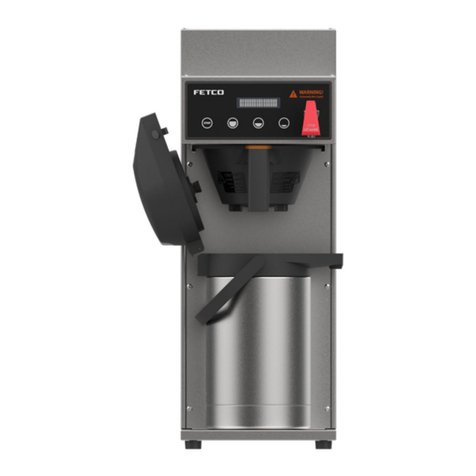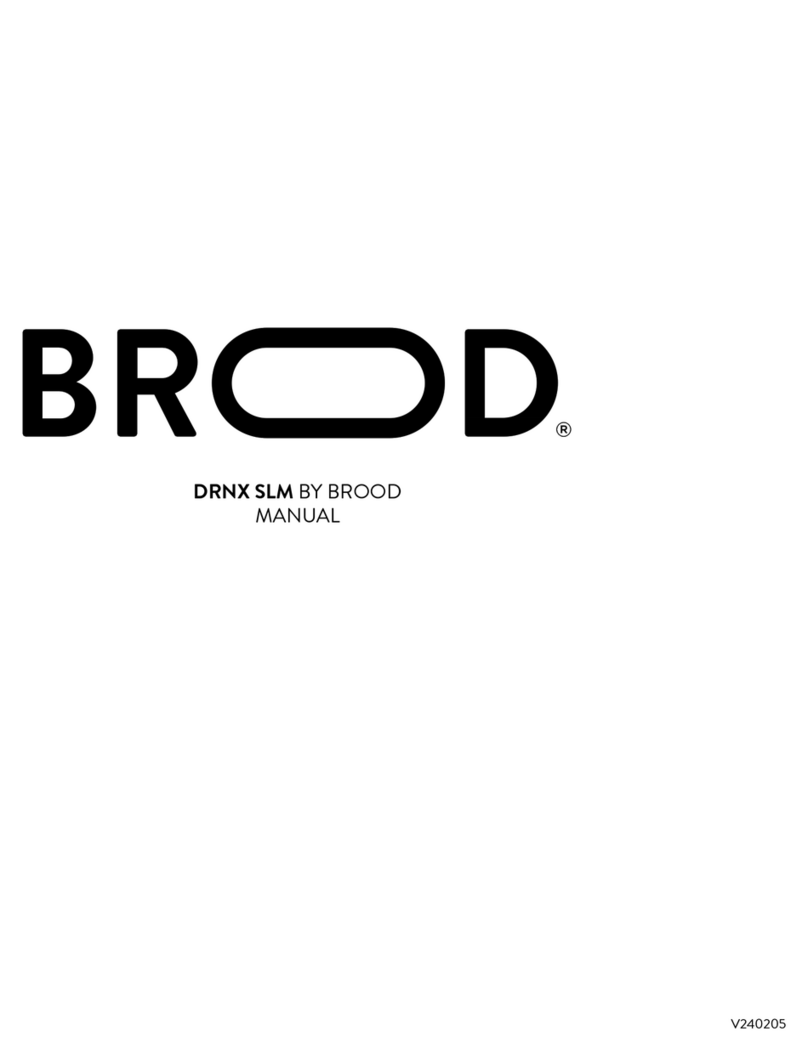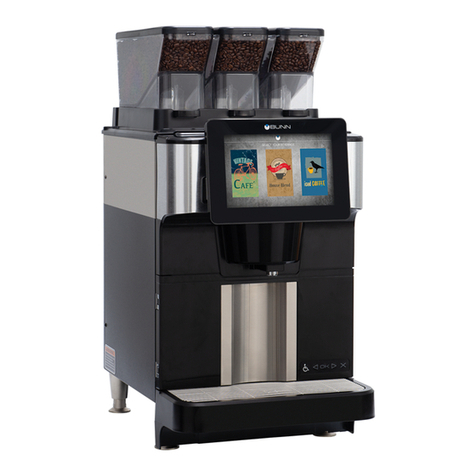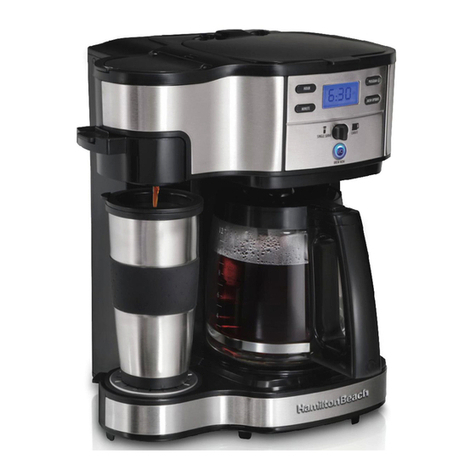DEMON BREWING BREWDEMON User manual

KITS INCLUDE:
1. Fermenter/Lid
2. Venting Plug
3. Tap Assembly
4. Fermenter Base/Legs/Plugs
5. Stick-on Temp Gauge
6. Recipe Ingredients (shown inside)
7. Bottles/Caps/Labels (not shown)
8. Mixing Spoon* (not shown)
9. Vinyl Hose/Bottle Filler* (not shown)
*Hard Cider Plus Kits only.
EQUIPMENT NEEDED:
•1-gallon Container
•3-quart Cooking Pot (or larger)
•Mixing Spoon (avoid using wood)
•Measuring Cup
•Paper Towel
•Can Opener*
*Needed with some recipes.
INGREDIENTS NEEDED:
•2-gallons of water
•2 cups of white granulated sugar
Twitter: @BrewDemon Facebook: /BrewDemon
ENJOYING YOUR HARD CIDER!
After your hard cider has carbonated or you decided to make a still cider,
good news, it’s ready to drink! However, you can improve the flavor by
bottle conditioning your cider. This can be done a couple ways:
A. Warm conditioning: Keep your bottles in a dark, dry location away from
sunlight and maintain a temperature between 50°- 70° F for several
weeks to a month.
B. Cold conditioning: Place your bottles in the refrigerator for several
weeks to a month.
Whether or not you choose to bottle condition your cider, it will always
taste better after chilling in the refrigerator for at least 24 hours. Then
it’s time to call your friends!
CARING FOR YOUR EQUIPMENT
Nobody likes dirty equipment, especially your cider. Here are some basic
tips to ensure your equipment is ready for the next batch:
1. Disassemble and clean your equipment promptly after using.
2. Always wash and rinse your equipment using a mild unscented soap.
3. Avoid anything that can scratch the inside surface of your fermenter.
4. Discontinue using equipment that is scratched and/or cracked. Bacteria
can hide in the smallest areas and could spoil your next batch.
4
ASSEMBLY NOTES:
1. Add plugs to base legs first, then twist legs into the base.
2. Tap: Washer goes on the outside of the fermenter. Hand-tighten
nut and test for leaks before making your hard cider.
DEMON BREWING CO., INC
PHOENIX, ARIZONA
FOR MORE INFORMATION CALL +1 800 372-2337
OR VISIT WWW.BREWDEMON.COM
INSTRUCTIONS
2-GALLON KIT ASSEMBLY AND BREWING
2
4
1
5
3
WARNING: OVER-TIGHTENING TAP NUT CAN CAUSE TAP TO BREAK.

1
BOTTLING / CARBONATING YOUR HARD CIDER
Some people prefer still cider (uncarbonated), for this you will need to skip
step 4. For everyone else, we need to add carbonation. It’s normal for this
natural carbonating process to create a small amount of yeast sediment at
the bottom of each bottle. This step should take about 45 minutes.
1. Dissolve the remaining One Step into a gallon of warm water.
2. Fill each bottle half full with solution, place caps on (just a few turns) and
shake a few times. Allow them to sit for a minimum of 10 minutes.
3. Remove caps and empty bottles. No rinsing is required.
4. Skip this step to make still cider (uncarbonated). Add 2-1/2 teaspoons
of white granulated sugar to each bottle. If you’re using bottles other
than what came with this kit, see our priming sugar chart above for the
correct sugar amount.
5. Using the tap, fill each bottle halfway up the base of the neck. Make sure
all bottles contain approximately the same amount of hard cider.
6. Cap each bottle and invert them several times until the sugar has been
completely dissolved. Do not shake bottles. For still cider skip step 7
and go directly to “Enjoying Your Hard Cider” on panel 4.
7. Place the bottles upright and out of direct sunlight. Maintain a
temperature between 64°- 86° F for approximately 7 days.
EVERY COUPLE OF DAYS GIVE EACH BOTTLE A SQUEEZE. WHEN THEY
BECOME FIRM TO THE TOUCH (LIKE A NEW 2-LITER BOTTLE OF SODA)
AND THE CIDER HAS CLEARED, THEY’RE READY FOR THE FRIDGE.
MAKING YOUR HARD CIDER
Our cider mix contain 100% pure apple juice and is ready for fermentation.
Just add water and the included yeast. Since hard cider is mostly water, the
better the water the better your cider. This step should take about 30 minutes.
1. Remove yeast packet from under the lid of cider mix (if necessary) and
stand can(s) in a tub of hot tap water. This will help them pour more easily.
2. Fill your fermenter with a gallon of cold water. For best results, use bottled
spring water or charcoal-filtered tap water.
3. Skip this step if you are making a basic hard cider recipe. Puree the can of
fruit in your sanitized blender.
4. Place 4 cups of water into a clean 3-quart pot and bring to a boil.
5. Remove from heat. Then slowly stir in the hard cider mix and 1 1/2 cups of
granulated sugar until it fully dissolves. This mixture is called the must.
6. Pour this must into the fermenter. Bring the volume of the fermenter up to
the 8.5-quart mark by adding more water. (Add your pureed fruit if you are
making cider plus fruit recipe). Mix thoroughly. Read the thermometer and
wait until the temperature of the wort is between 64°- 86° F before
proceeding to the next step.
7. Add the yeast. Then attach your lid.
8. Place the fermenter out of direct sunlight and maintain a temperature
between 64°- 86° F for approximately 7 days.
AND NOW YOU WAIT
After 7 days the hard cider in your fermenter should have stopped fermenting
and begun to clear. It’s now time to bottle! If you’re not sure, draw a small
amount from the tap; if it tastes dry and tart like still cider, it’s ready to bottle.
If it tastes sweet, give it a few more days.
PRIMING SUGAR CHART:
We recommend using white granulated sugar in the amounts below:
12-ounce bottle use . . . . . . . . . . . . . . . . . . . . . . . . . . . . 3/4 teaspoon
16-ounce bottle use . . . . . . . . . . . . . . . . . . . . . . . . . . . . . . 1 teaspoon
20-ounce bottle use . . . . . . . . . . . . . . . . . . . . . . . . . . 1-1/4 teaspoons
22-ounce bottle use . . . . . . . . . . . . . . . . . . . . . . . . . . 1-1/2 teaspoons
1-liter/quart bottle use (most kits) . . . . . . . . . . . . . . 2-1/2 teaspoons
2-liter bottles use . . . . . . . . . . . . . . . . . . . . . . . . . . 1-1/2 tablespoons
3-liter bottles use . . . . . . . . . . . . . . . . . . . . . . . . . . 2-1/4 tablespoons
SANITIZE YOUR EQUIPMENT
This is perhaps the most important step in the brewing process. It kills
any bacteria, wild yeast and mold that can cause off-flavors. It’s important
to sanitize everything that comes in contact with your cider. This step
should take about 15 minutes. FOR CIDER WITH FRUIT RECIPE YOU
WILL NEED TO SANITIZE A BLENDER (SEE STEP 5).
1. In a container, dissolve half (1 tbsp) of the One Step No-Rinse Cleanser
into a gallon of warm water. Shake until the cleanser has completely
dissolved. Save the other half of the cleanser for bottling.
2. Pour solution into the fermenter, screw on the lid and place your
venting plug into its hole. Cover venting plug with your hand or finger
and swirl the solution around making sure it contacts the entire inside
surface including the lid.
3. Open and close the tap several times to sanitize the inner surface.
4. Place your mixing spoon(s), measuring cup and can opener (if needed)
inside the fermenter. Careful not to scratch the inside surface. Allow this
to soak a minimum of 10 minutes.
5. Skip this step if you are making a basic hard cider recipe. Pour the
solution from your fermenter into the blender and repeat the second
part of step 2. Allow this to soak a minimum of 10 minutes.
6. Drain fermenter. Remove your utensils and place them on a clean paper
towel. No rinsing is required. You can alternatively sanitize a plate or
bowl to use as a utensil rest.
3
WARNING: BOTTLING TOO SOON OR WITH TOO MUCH PRIMING
SUGAR CAN RESULT IN OVER-CARBONATION, WHICH MAY CAUSE
YOUR BOTTLES TO GUSH OR BURST. LET’S NOT DO THAT!
2
HARD CIDER DRY
YEAST PACK
YEAST
HARD CIDER DRY
YEAST PACK
YEAST
CIDER MIX CLEANSER
BASIC HARD CIDER RECIPE
ABV 3.0%
CIDER MIX FRUIT CLEANSER
HARD CIDER PLUS FRUIT RECIPE
ABV 4.0%
Table of contents
Popular Brewing System manuals by other brands
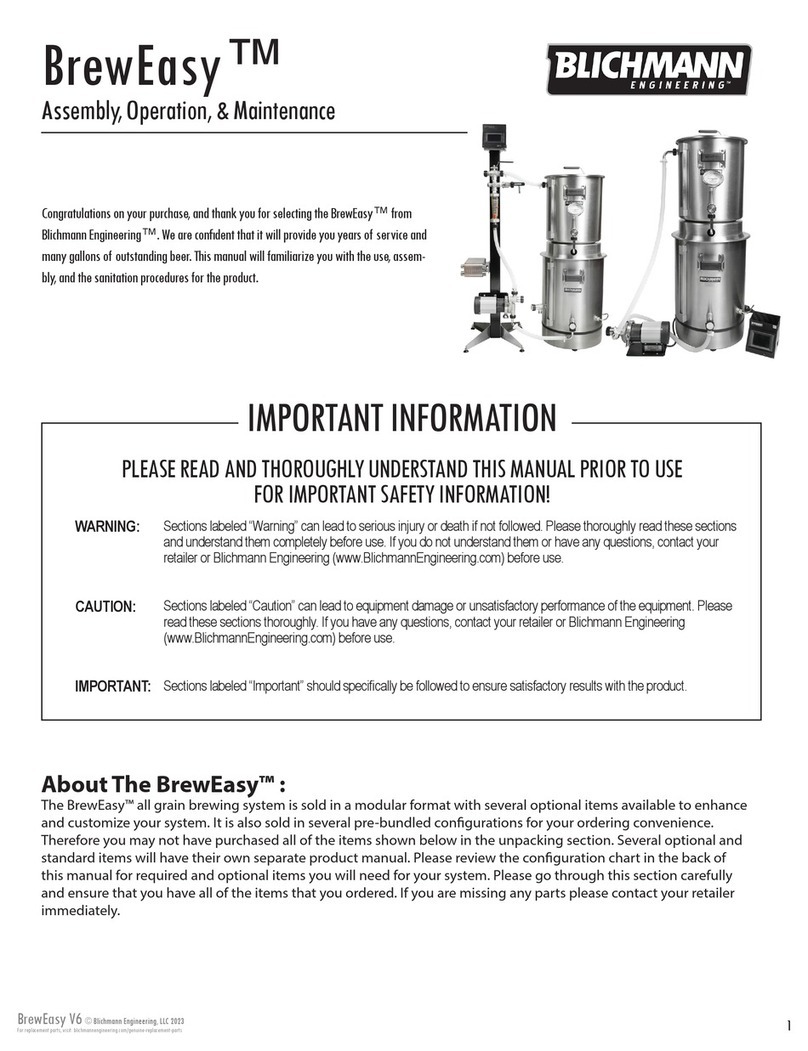
Blichmann Engineering
Blichmann Engineering BrewEasy Classic Assembly operation maintenance
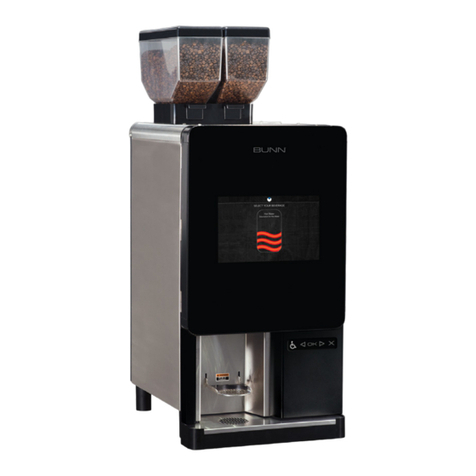
Bunn
Bunn Sure Immersion 220 Programming manual

Wilbur Curtis Company
Wilbur Curtis Company G4CBHS user guide
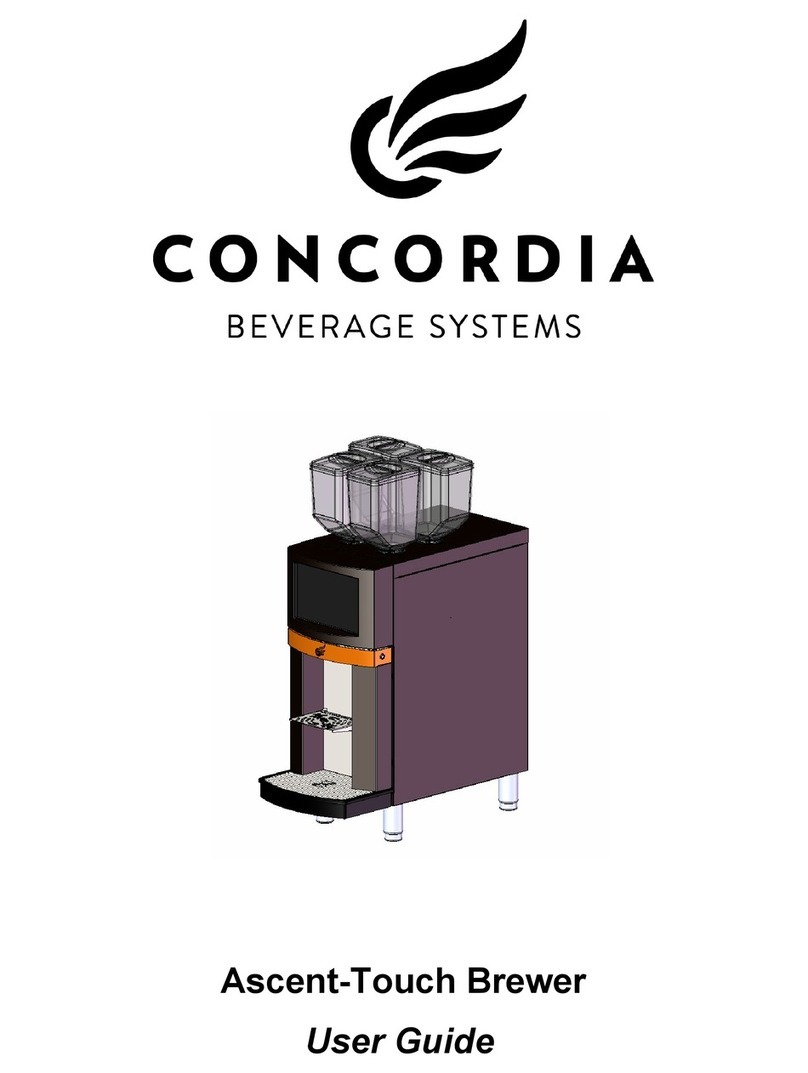
Concordia
Concordia Ascent-Touch user guide
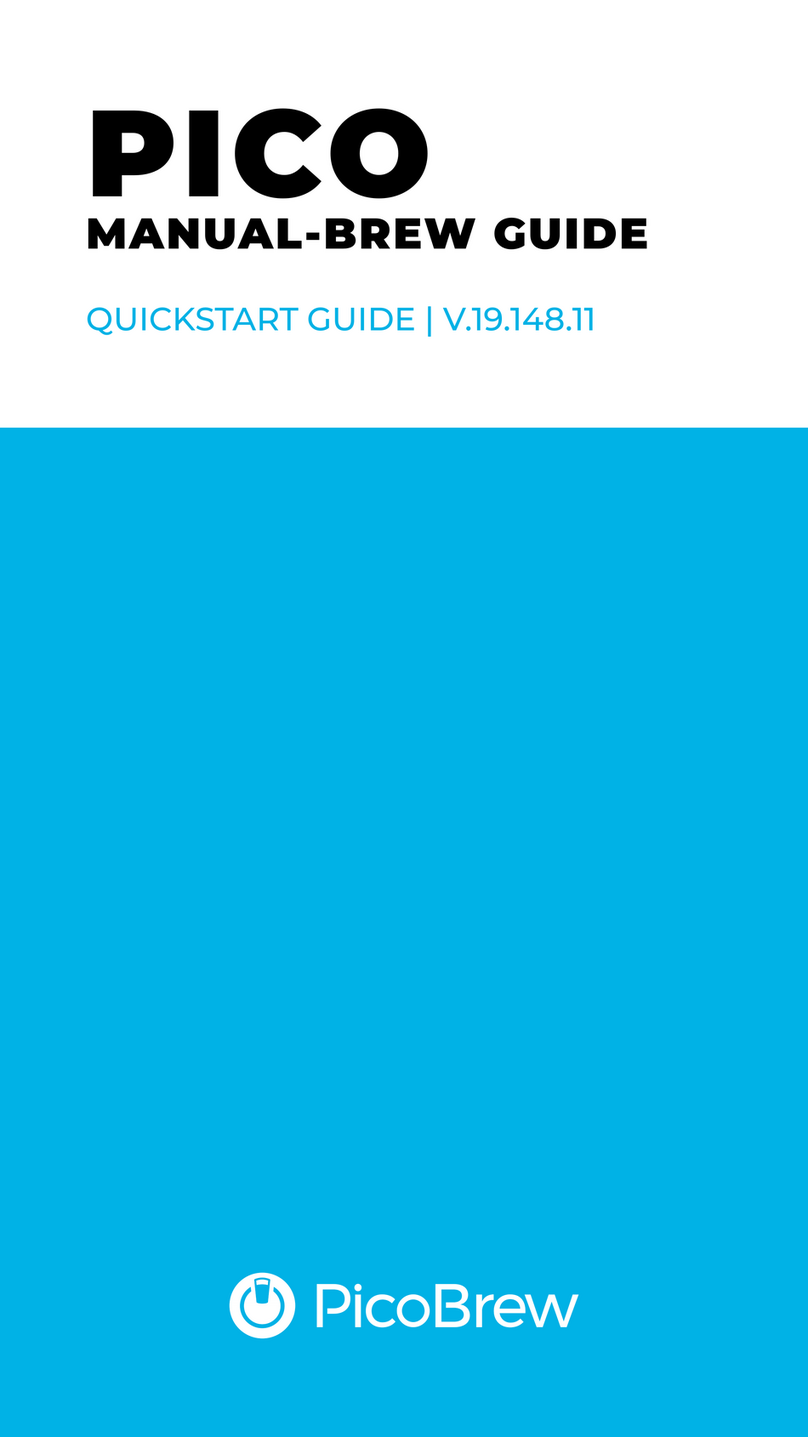
PicoBrew
PicoBrew Pico C quick start guide
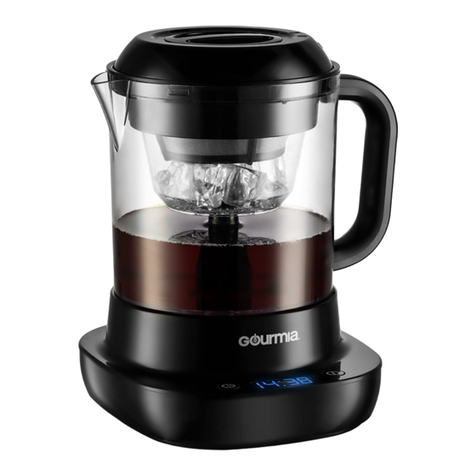
Gourmia
Gourmia GCM-6850 user manual
